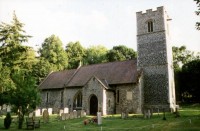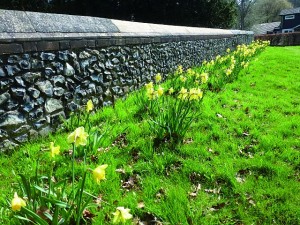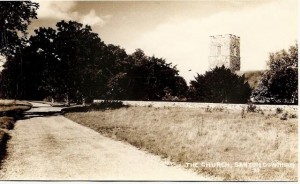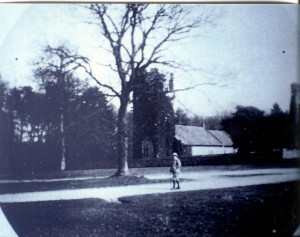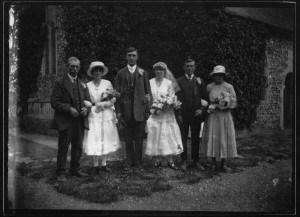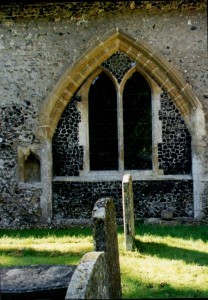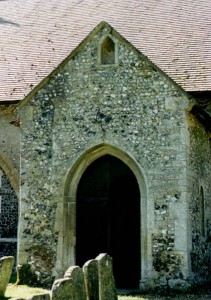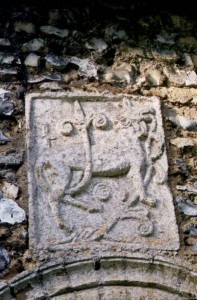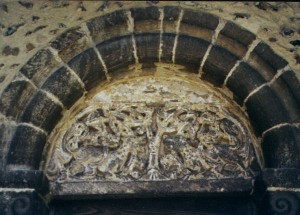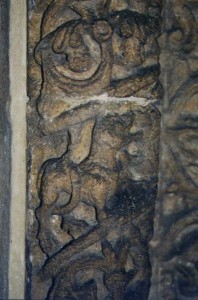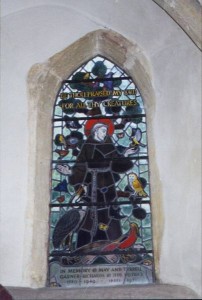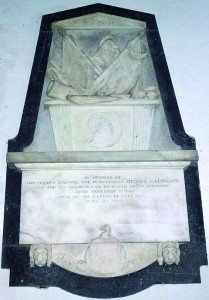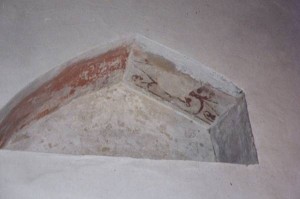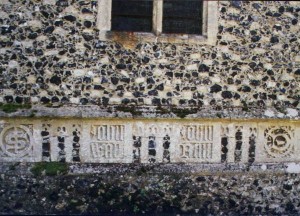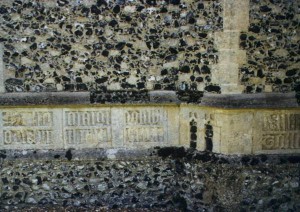St. Mary’s Church in Santon Downham is set in a most tranquil spot on the edge of the forest at the end of the large village green. The Domesday Book notes the existence of a church in the village, most probably wooden and replaced by the present one. The Nave was begun in the 12th century and built towards the east culminating in the chancel which was finished during the 13th century. The tower was built between 1460 and 1500 as a result of bequests made by various members of local families. Interesting to note on the north side of the tower about two thirds up there is a yellow brick that marks the spot, reputedly, of the level at which the sand came to rest in the famous sand storm of 1668.
The daffodils in the photograph first flowered in 2013 and were planted around the church wall by the Sayer family in memory of Vera’s mother Annie Royal.
This little church contains some fascinating anomalies: next to the north porch outside, there is evidence of an additional, or most probably, an earlier Trinity chapel; there is an arch filled with knapped flint and to the east a very well preserved piscina, the little niche above the door in the porch is off centre, indicating that the much thicker east wall of the porch was orginally the west side of this chapel, most probably destroyed during the Reformation. Above the south doorway there is a carved stone panel depicting what could be a wolf (symbolising evil) devouring the tree of life,which, indestructible sprouts from the wolf’s tail – symbolic of the Resurrection? (Similar depictions may be found on two capitals in the north transept of Ely Cathedral and on the Norman tympanum of the Tree of Life at Wordwell, 10 miles from Santon Downham). High up in the south wall of the nave is an arched opening, having in it the remains of a mediaeval scroll painting, but it bears no relation to anything else in the church.
Within is a 13th or 14th century font and an early 14th century screen, crude and heavy in design but with a curious roughly cut double arch in one panel of the dado, possibly a primitive confessional. The altar cross, candlesticks and the processional cross all in wood are modern and were made by a local forester. There are some fragments of mediaeval glass in the South chancel window but otherwise all the stained glass is Victorian except for the 1952 window in the south wall of the chancel by Harcourt Doyle.
The memorials relate to the various landowners and their families connected with the village, notably the Wrights from the 17th and 18th centuries, through the Cadogans to the last ‘squire’, Colonel Edward Mackenzie who died in 1929. The unveiling of a memorial tablet to Col. Mackenzie was reported in the Bury Free Press in December 1933.
Fundraising has been needed over the years to keep the Church in good repair and the Bury and Norwich Post reported one such event in August 1890. The church’s re-opening in 1893 appeared in The Bury Free Press. Fund raising continued and in 1894 Amateur Dramatic entertainment was reported in the Downham Market Gazette.
There is a large memorial inside to Lieutenant Colonel The Honourable Henry Cadogan who was killed at the Battle of Vittoria in Spain during the Peninsular War.
Outside in the graveyard, near the gate is to be found the remains of a mediaeval churchyard cross, from the time when a single cross or crucifix commemorated all souls.
Simon Knott has a website which features suffolk churches including Santon Downham and All Saints
The Corpus of Romnesque Sculpture also feature the church
The Register of Baptisms, Marriages and Burials dates from 1579 and is complete from that date.
St Mary the Virgin – A closer Look
The Church in the Forest otherwise known as St. Mary the Virgin Santon Downham is set in a most tranquil spot on the edge of the forest at the end of a large village green.
The Tower
The tower was built between 1460 and 1500 by a consortium of local benefactors who had their names inscribed in stone at the base of the tower and whose wills show them to be closely related – as one would expect in such a small community. Here, thanks to detailed notes on the church courtesy of John Fitch M. A. aided by Mr. Peter Rattlesden the inscriptions are brought to life:
The Life of The Church
Running an ancient village church involves considerable time and expense. It is a task that is all the harder in a tiny village, with few people to share the load. The burden of preserving the most important building in the parish falls on a few households, explained Churchwarden and treasurer Andrew Kedar. Most do not wish to pay.
Fundraising
Money has to be raised both to keep the building in good repair, and to contribute as much as £6,000 a year to help pay for the Rector and other administrative costs of the Diocese. The chuch also raises money for charity,

